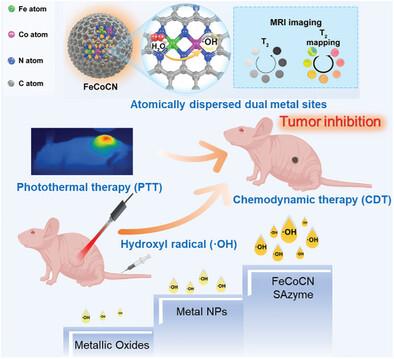Atomically Dispersed Dual Metal Sites Anchored Catalyst Enables Photothermally Augmented Catalytic Oxidation for Biocatalytic Tumor Therapy
IF 18.5
1区 材料科学
Q1 CHEMISTRY, MULTIDISCIPLINARY
引用次数: 0
Abstract
Single-atom nanozymes (SAzymes) can maximize atomic utilization efficiency and construct highly active catalytic sites for biomedical applications. Herein, atomically dispersed iron (Fe) and cobalt (Co) dual sites anchored N-doped graphene carbon (FeCoCN) catalyst is rationally constructed to achieve photothermally augmented catalytic oxidation for effective biocatalytic tumor nanotherapy. Compared with Fe SAzyme, FeCoCN SAzyme can significantly accelerate the charge transfer and improve the activity of catalytic reactions. Co-doping optimizes coordination structure and charge redistribution by facilitating the ratio of Fe2+ and regulating charge transfer between different metal sites and nearby coordination atoms. Bimetallic FeCoCN SAzyme possessed an ultra-high affinity for substrate H2O2, and the catalytic kinetic Km value (0.589 mm) is superior to natural catalase and most reported nanozymes. The boosted catalytic activity in producing •OH is identified by density functional theory (DFT) studies. In vivo, investigation demonstrates that atomically dispersed Fe and Co dual sites anchored FeCoCN SAzyme significantly suppresses tumor proliferation under NIR laser irradiation by photothermally enhanced catalytic oxidation. Additionally, Fe- and Co-doping in FeCoCN make it suitable as a tracer for T2 magnetic resonance imaging. This work provides a paradigm to rationally design bimetallic SAzymes with enhanced biocatalytic performance for tumor treatment.

原子分散的双金属位点锚定催化剂使光热增强催化氧化用于生物催化肿瘤治疗
单原子纳米酶(SAzymes)可以最大限度地提高原子利用效率,构建高活性的生物医学催化位点。本文合理构建原子分散的铁(Fe)和钴(Co)双位点锚定n掺杂石墨烯碳(FeCoCN)催化剂,实现光热增强催化氧化,用于有效的生物催化肿瘤纳米治疗。与Fe SAzyme相比,FeCoCN SAzyme能显著加速电荷转移,提高催化反应活性。共掺杂通过促进Fe2+的比例,调节不同金属位和附近配位原子之间的电荷转移,优化配位结构和电荷再分配。双金属FeCoCN SAzyme对底物H2O2具有超高亲和力,其催化动力学Km值(0.589 mm)优于天然过氧化氢酶和大多数已报道的纳米酶。通过密度泛函理论(DFT)研究,确定了提高的催化活性生成•OH。在体内,研究表明原子分散的Fe和Co双位点锚定的FeCoCN SAzyme在近红外激光照射下通过光热增强的催化氧化显著抑制肿瘤增殖。此外,FeCoCN中的Fe-和共掺杂使其适合作为T2磁共振成像的示踪剂。这项工作为合理设计具有增强生物催化性能的双金属SAzymes用于肿瘤治疗提供了一个范例。
本文章由计算机程序翻译,如有差异,请以英文原文为准。
求助全文
约1分钟内获得全文
求助全文
来源期刊

Advanced Functional Materials
工程技术-材料科学:综合
CiteScore
29.50
自引率
4.20%
发文量
2086
审稿时长
2.1 months
期刊介绍:
Firmly established as a top-tier materials science journal, Advanced Functional Materials reports breakthrough research in all aspects of materials science, including nanotechnology, chemistry, physics, and biology every week.
Advanced Functional Materials is known for its rapid and fair peer review, quality content, and high impact, making it the first choice of the international materials science community.
 求助内容:
求助内容: 应助结果提醒方式:
应助结果提醒方式:


